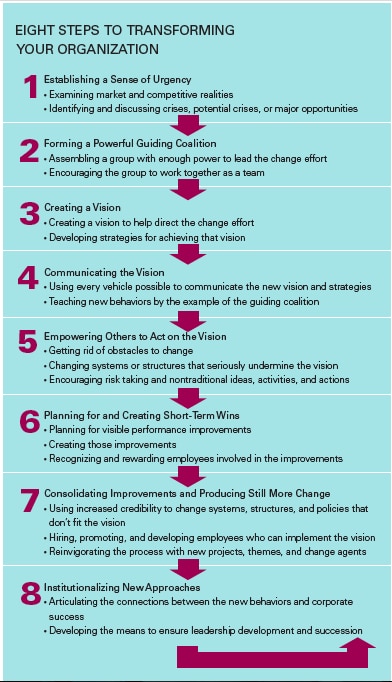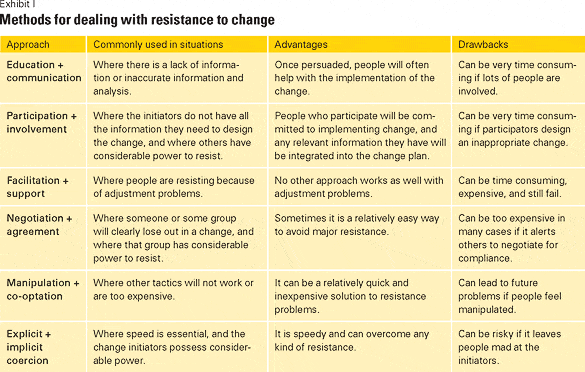Kotter’s Eight Steps Process for Leading Change can be considered an expansion of Lewin’s three-step model, albeit being more detailed and focusing more on the people (particularly Leaders) behind it. The basic idea is that by inspiring a sense of urgency for Change and maintaining that Momentum, Kotter’s theory can be used to significant effect in adapting your business to the environment.
John Kotter studied all of the places where failures could occur in Lewin’s model. Kotter recognised that several things needed to be added in:
- a sense of urgency around Change
- a coalition for managing the Change
- a communicated vision for the Change
- the removal of obstacles to accomplishing Change
- the continued pursuit of Change in spite of the apparent victory
- anchoring of the changes into the organisation’s culture
The Model
Kotter expanded Lewin’s “unfreezing” step with his first four recommendations. His steps five, six, and seven correspond with Lewin’s “movement” stage, and step eight is parallel with the “refreezing” process.

But let’s see the eight steps more in detail.
1. Create a Sense of Urgency
The first step is to generate a sense of urgency for your Change programme. This will provide the necessary initial traction, helping to get the team onboard and motivated. Kotter model does not spend too much time on the analysis of the reasons for the problem, but it is implicit that a correct diagnosis is needed to make this step more effective.
This element is core in Kotter’s model. Achieving a Sense of Urgency means understanding current potential threats, competition and any opportunity you can exploit. With these, you can initiate a conversation that will ultimately push the entire company in succeeding with Change.
2. Build a Guiding Coalition
Once the Sense of urgency is set, you need to have a strong sponsorship for the Change Programme to succeed. Kotter underlines here the need to establish a team of people who have enough power and influence to make Change happen. The concept of a Steering Committee for change programmes is primarily linked to this step.
In recent time it has become more and more critical to represent not only key decision-makers but also the entire diversity of an organisation (particularly for large scale transformations). This helps to build bridges across organisation silos. Which is why it is also essential from the very beginning to establish the correct operational governance for this team to act upon the Change process.
3. Form a Strategic Vision
Kotter’s point of view on Change Leadership is evident through this process. He focuses a lot on the creation of a Vision statement for the Change Programme, that can easily carry the message of the “why” we need to change. The key here is not to overwhelm whoever’s listening to you with detail or complicated ideas or language.
Managers are trained to make incremental, programmatic improvements. They aren’t trained to lead large-scale change.
John P. Kotter
4. Enlist a Volunteer Army
It’s now time to spread the idea to the entire organisation, transforming as many people as possible into real “Change Agents”. This is one of the most misunderstood steps in the process. It’s not about creating a separate organisation that promotes Change, but rather ensuring that there are enough people in the organisation proactively supporting Change. This is key for any manager in the organisation, and is intrinsically linked to the concept of enabling to reach the critical mass to achieve the “tipping point” and make Change.
It’s all about proactive and focused communication, with real involvement. Not just a top-down approach, but rather a continuous feedback loop.
5. Enable Action by Removing Barriers
Implementing Change is all around creating consistency. Which is why a big part of the effort should be focused on removing barriers to change. Often underestimated, this step is critical in the process. But what can barriers be?
Many managers underestimate the variety of reactions to change and their power to influence those responses.
John P. Kotter
Kotter & Schlesinger have identified several Barriers, and also developed six specific actions that can be implemented for each type of barrier, with varying degrees of effectiveness. The types of obstacles they identified are:
- Parochial self-interest.
- Misunderstanding and lack of trust.
- Different assessments.
- Low tolerance for Change.
Each of these issues deserves a different strategy, and the two authors have identified six methods, each applicable depending on the situation.

6. Generate Short Term Wins
We have now started to implement Change. However, we need to ensure that Motivational levels stay positive along the process. Especially when the change programme is long, it is necessary to identify short term wins that can be celebrated along the way, to ensure reward and employee engagement are stimulated.
This will give the teams a sense of accomplishment and will show them the Change process working in action. It’s not just about milestones set in advance, but it is also about recognising Change effects along the way (for example in the Barrier removal process).
7. Sustain Acceleration
This step is all about sustaining the Momentum generated by Change. The idea is to rush in the consolidation phase with loads of positive energy, to deliver results higher than what planned initially.
To achieve this, it is necessary to have an active feedback cycle. Identifying issues during the Change programme, and immediately taking action, is the best way to help with the acceleration process.
8. Institute Change
Finally, it’s time to set the changes in stone. You need to ensure Change sticks, not just in the formal documentation, but in the behaviour of employees. This means creating consistency with rewards and incentives, career conversations and in general, the celebration of success.
The worst mistake can be to just leave the end of the project to a couple of drinks and some stale sandwiches. This Institutionalisation process is critical in the creation of lasting effects and needs to be planned and executed correctly.
What’s good about the model
Compared to Lewin’s model, Kotter theory is fantastic in the level of details it gives in the initial steps of the process. It forces to set the foundation for success by focusing on the necessary Sense of Urgency and sets the Leadership team to be trill influential in enacting Change. With enough resources, the deployment should simply follow the flow.
What’s bad about the model
The problem, however, lies in the Execution phase. Kotter’s model is a top-down approach at heart. To be accurate, the author insists a lot on the role of Leadership (in a diffused sense, not just hierarchical) and makes a constant point on not mixing Management and Leadership. However, in the practice of most adopters of the model, it became a pure “enforcement” tool, with the risk of alienating employees through the process.
This is particularly visible in the fact that the execution steps are the focus on only two stages of the chain. Seen from the PMO office, this means spending the majority of resources in the initiation phase (which is all about “managing towards the top”) and far less on the sustaining of Change.
Conclusion
Kotter’s Eight Steps Process for Leading Change is an excellent checklist of elements that are needed during a Change programme but lacks the actionable instructions to be a step-by-step process. For this reason, too many programmes that are inspired by these steps, fail to deliver the value because they fail to cement the Change in the organisation’s stakeholders.
However, two elements (the creation of a Sense of Urgency and the Barrier Removal steps) are critical to be kept in mind in any change process. They are probably one of the most vital contributions fo this model for the Change Management practice.
This post belongs to a series of articles related to Change Management. An introductory article: Change Management: The 10 Best Approaches & Models is available, containing links also to all other posts of the series.
And you? Have you seen this model successfully implemented?


Great practical info on Kotter. I really like your posts. Prosci and Kotter and change management in general is becoming essential to HR and general leadership
[…] Change, except that it does not provide a sequence of the elements that are needed. Compared to Kotter’s model, for example, it lacks the direction or phasing of the various […]
[…] than a Change Management like Lewin’s or Kotter’s, the McKinsey 7S Framework is a helpful diagnostic tool to initiate and sustain Change. Complex to […]